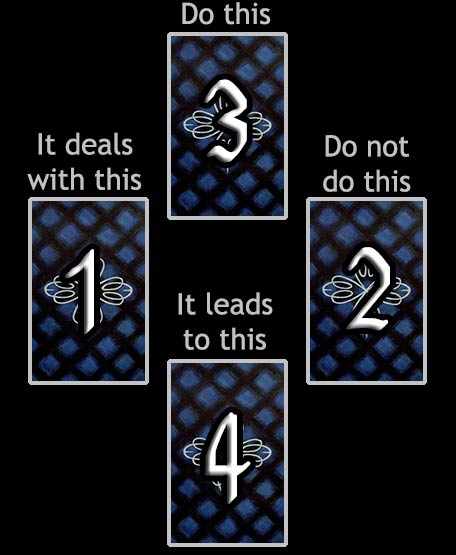Cross Spread

Difficulty: Easy
The Cross Spread is good for questions asking for advice. It can also be used to determine the meaning of a confusing card from a previous reading, or for that matter, to shed light on other points of confusion.
In questions asking advice, this tarot spread is self-explanatory. The main thing is to determine the difference between cards #2 and #3. #1 is the topic and #4 is the result.
In questions regarding confusion, such as: "What was the meaning of Card (X) in the last spread?" the main thing is also to determine the difference between cards #2 and #3. In this case, #2 will show what the card was not referring to, and Card #3 will show what was really meant. Card #1 is the topic and #4 represents the purpose it serves.
Your Cross Reading
DO This The Hanged Man |
||
It Deals with This The Magician |
Do NOT Do This Justice |
|
It Leads to This The Chariot |

It Deals with This
The Magician
The symbols of all the elements are shown on the picture as possibilities. The eye, with its triangular shape, refers to the Holy Trinity. It seems as though it has just opened and one can recognise the spokes of the Wheel of Fortune in its iris.
The ribbon of eternity shows us how all possibilities can develop in waves out of the one item. The red background supports the energy of the illustration.

Do NOT Do This
Justice
The striking red background of the picture shows that justice has to be very often looked for in emotional situations. Libra's sword and suspension are blue. This stands for rational action. The sword with its double cross the card's eight. The violet colour of the bowls shows the necessity for openness and entirety.
Both hands are equally involved in the weighing process. Rationality and intuition are both important. The eye is half open, it is looking both outwardly and inwardly. The fruits symbolise maturity, which has to reach a good decision for justice.

DO This
The Hanged Man
The sole of the foot is turned upwards, the world is turned upside down. This is what the picture shows. The beam and the rope are blue. Rationality, an attempt to consciously act, binds the hanged man. But here there also seems to be hope. Leaves are growing out of wood.
The colour yellow at the bottom of the picture stands for the light which the hanged man experiences when he manages to let himself fall. The wide path in the background leads to a dead-end against blue rocks. Walking back a bit one can find a narrow track which leads around the rocks back into the light. The violet background portrays the night sky. Normal vision is not carried any further.

It Leads to This
The Chariot
The chariot itself is portrayed by the wheel. It has eight spokes, a symbol for the process of development. The shaft symbolises the centre and also the number nine, which completes the cycle. Hub and shaft are on fire and stand for sexual energy. Origin, the wheel's background, and destination, the celestial body's background, are the same colour, violet, which stands for the spiritual.
The dominating yellow in the picture depicts joy of living. The water at the bottom indicates frankness or naivety, but also emotions to be conquered, such as caution or fear. Black and white reins, held in the right and left hand, show different directions and ambivalences, which have to be brought into harmony to make the journey possible. The next part of the journey, which lies ahead of the coach driver, the material world, represented by green, square fields, opens up within all this.
Libra's symbol (justice) shows that one has to reckon with consequences for any mistakes. The section at the top leads into the night. The coach driver does not encounter the sun, as to be expected, but instead the moon and stars. He will meet intuition and the unconscious.
